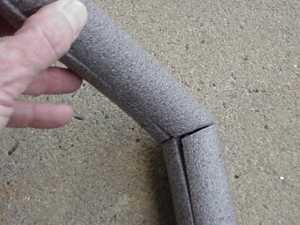


|

|
Installing Pipe Insulation |
|
It is generally advisable to insulate your copper water pipes, especially in the basement or crawl spaces. In the basement, the combination of humidity and cold water running in the pipes can cause condensation, or sweaty pipes. Your hot water pipes should also be insulated to conserve the heat, especially on long runs from the hot water heater to the show, bath or kitchen. There is a simple solution. Wrap your pipes with polyethylene flexible tubing. In this article, we show you how to cover your pipes. While this will not guarantee that your pipes won't freeze, it is good protection in cold climates. |
 |
|
Items needed:
Plaster of paris (compound) |
Safety Suggestions and Tips
Wear safety glasses
Check local codes If working in crawlspace, make sure somebody knows you are there. |
Level of difficulty
 Time Required: 2 hours
|
|
|
|
Steps |
|
|
|
|
Step 1: First you need to inventory how much material is needed. You probably have a combination of 5/8" and 1/2" pipe, although there may be several lengths of 3/4" or larger pipe. I would recommend using 3/8" thick polyethylene foam pipe insulation, typically sold in four 3-ft sections. Do not try to use just one size or your efforts will generally be ineffective. Separate the the insulation along the slit and slip this over the copper pipe. You may find obstructions and will need to trim the insulation to fit. |
|
Step 2: When you get to an bend or elbow in the pipe, you'll need to cut wedges in the insulation. I find that scissors work great for this, but a knife works as well. |
|
Step 3: On a gradual bend in the pipe (no coupling), cut several wedges less than half way through the insulation. For sharp corners with couplings, you will want to make one large wedge cutting through about 3/4 th's of the insulation on 45 degree angle. Where you have a t-connection, you'll need to both notch one section of insulation and miter the stub piece. |
|
Step 4: Now with all the pipes covered you should tape the seam using the manufacturer's recommended weatherproof tape or duct tape. |
|
|
|
|
Related articles
|
||||